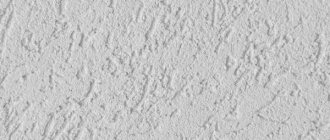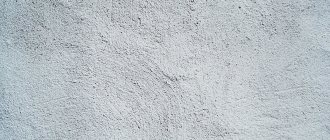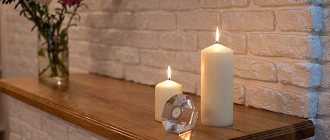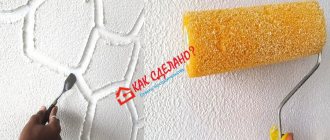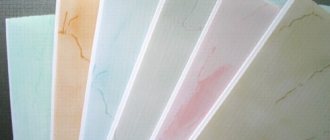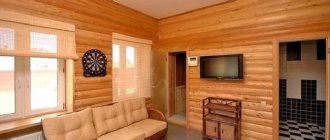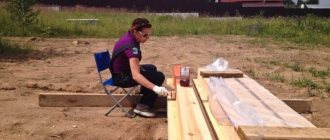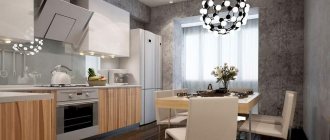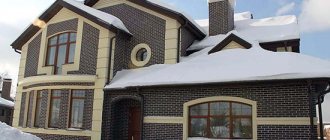Any home owner, when starting to decorate the interiors of his property, wants to give it a neat and beautiful appearance, consistent with a certain design style, and, if possible, add a kind of “zest” that attracts the eye, but at the same time ideally harmonizes with the general direction. As such an “accent”, clinker tiles with imitation brickwork can be used.
Clinker tiles for interior wall decoration
Many may think that a “brick interior” is not cozy enough. But, firstly, there is no arguing about tastes, secondly, the styles of decorating rooms differ in many ways, and thirdly, you can observe moderation in everything - it is not at all necessary to cover all the walls with similar images - sometimes a small area is quite enough to give the premises a unique look. In a word, clinker tiles for interior wall decoration are a fairly popular material. This will be discussed in this publication.
Clinker tiles - what is it and where does the name come from, how did clinker appear?
Holland is considered the birthplace of clinker. The name was given to it due to the characteristic sound made by clay tiles and bricks after pressing and firing, when tapped.
One day, residents had a need for a material whose performance characteristics would be no worse than stone, as a result of which the technology for producing clay clinker was developed. The mass was baked in ovens, subjecting it to high temperatures. clinker tiles , brick material and other analogues used in finishing work were obtained
A building material whose characteristics correspond to natural stone quickly became popular. They began to use it for building roads and finishing houses.
Laying
Simple installation is also an important advantage of this material. To do this, you will need a special adhesive for interior finishing work, which is applied to the walls and the tile element itself.
To evenly distribute the adhesive mass over the surfaces of the finishing material and walls, you can use a notched trowel.
Laying clinker tiles is carried out similarly to conventional ones. At the same time, it is necessary to monitor the quality of work related to the alignment of seams, which should be no more than 12 mm, and corners.
The material is easy to saw and allows you to create unique design solutions.
The last stage is grouting the tile joints with special compounds or sand-cement mortar.
After this, the glue and solution must dry for a certain time. At the end of the work, jointing is done with special materials.
Installation work when laying clinker involves performing certain actions:
Preparation of a special adhesive solution for tiles of ideal consistency. Before starting work, clinker products are soaked in clean water.
Installation of clinker, pressing it well to the surface.
Checking the smoothness of the work using a building level.
Grout after at least 2 days.
Cleaning the surface from dirt and glue.
Clinker tiles for bathroom
This material is often used for cladding buildings and structures for various purposes. With the help of clinker , facades are given an aesthetic appearance and protection from negative factors is created. Facing tiles are used to decorate previously prepared and leveled surfaces, creating the appearance of brickwork. In addition, such material is considered primary for the manufacture of facade panels.
Clinker tiles , intended for interior wall decoration , have four varieties, differing from each other in purpose and technological features. To decorate the bathroom, a waterproof material is used that almost does not absorb moisture and is not amenable to changes in temperature.
Main properties and features
The material owes its environmental safety, resistance to wear and tear and high temperatures to the raw material of natural origin - clay.
The differences in this material make it possible to use it for repairing external and internal surfaces; there are options for clinker floor tiles .
The production process is a time-consuming procedure during which the material gains strength and resistance to aggressive influences. Thanks to firing, the tile receives a dense structure resembling a monolith.
As a rule, the surface of the material is smooth, which allows you to glue it to various walls without particularly worrying about upcoming maintenance.
Often asked
Are clinker tiles safe indoors?
Absolutely Traditional technology uses only natural, environmentally friendly materials. Flexible clinker includes polymer binders, which also do not pose a risk to human health.
Is it possible to use flexible clinker in the fireplace area?
No, polymer materials do not have the required level of heat resistance.
What thermal insulation materials are best used under clinker tiles?
There are no special requirements here; almost any kind, both sheet and fibrous, will do.
What is the width of joints for classic clinker?
Since it imitates brickwork, the width of the joints must meet these requirements and range from 8 to 12 mm.
How long will classic and polymer clinker last?
Manufacturers of traditional clinker tiles guarantee 25 years, flexible - 5-7 years.
Specifications
Since clinker externally resembles brickwork, its dimensions practically coincide with the dimensions of the total stone, the only difference being its thickness.
This size depends on the purpose of the clinker tile and on the type of wall decoration for - interior or exterior. Based on this, the manufacturer presents samples of materials whose thickness is 0.5, 0.7, 1.2, 1.7 cm, with the second option being more popular.
The dimensions of the tile material are determined by GOST and are 115 by 240 mm, but some manufacturers produce other options:
- long (L-NF) – 295 by 71 by 15 mm;
- medium (WF) – 215 by 65 by 15 mm;
- small (WDF) – 21 by 5 by 2 mm.
The composition of clinker tiles , in addition to clay, which is considered the main raw material, includes other components of natural origin that give the material the necessary texture .
The main characteristics are:
- moisture resistance – 0.5 – 3%;
- thermal conductivity – 0.021 W/m;
- frost resistance – from +150 to – 180 degrees;
- pore closeness – up to 95%;
- density indicator – 45 – 55 kg per cubic meter;
- vapor permeability – 0.05 mg;
- attaches to concrete, brick and wood surfaces.
Types of clinker tiles
Considering the purpose and technical features of clinker tiles , there are four types of this material:
- standard. These clinker tiles are used for finishing residential premises. It is durable and has a long service life, is available in a wide variety of textures and a rich palette of color shades;
- waterproof. The material is resistant to moisture, almost does not absorb water, and is used to decorate a bathroom, swimming pool or sauna;
- technical. These tiles are used to decorate laboratory buildings and industrial facilities. Compared to other types, this material has a larger thickness, is not painted, can withstand mechanical loads well and is resistant to chemical agents;
- special purpose tile material. They are used to decorate architectural structures and line the interior walls of buildings.
The decor of the tiles is limited, the sizes and shapes are monotonous, and the color range is wide.
In addition to their purpose, tiles based on their texture are divided into the following groups:
- smooth. It is the most popular option and is used when renovating any room. Externally it resembles ceramic brick and is not difficult to maintain;
- glazed. The surface of this material is ideally smooth and shiny, the walls look stylish after finishing;
- rough. Another excellent option for renovation, which has one limitation - tiles for finishing the floor and walls in the kitchen , because they quickly lose their attractiveness. Rough surfaces quickly accumulate dirt, and it is quite difficult to clean such a surface;
- rustic. Outwardly it looks rough, resembles an aged brick or poorly processed stone, and is used when decorating interiors in loft, rustic, industrial styles, etc.
smooth
glazed
rough
rustic
Advantages
The main advantages of the properties of this finishing option include:
- Fire resistance;
- Antistatic;
- Resistant to temperatures below zero;
- Resistance to sudden temperature changes;
- Easy to clean due to its hygiene;
- Non-susceptibility to ultraviolet radiation;
- Resistant to reactions to chemicals.
Thanks to the above advantages of tiles, they are ideal for living rooms of any building.
Such a coating can be washed off without much effort from any contaminants, without losing its visual appeal during long-term use.
Additionally, clinker coating will increase the fire safety of housing.
Colors and design
The shades of the tile material depend on the color of the clay used in production and on the temperature at which the raw materials were fired. In most cases, red or brown material is made.
By adding color pigments, the color of the products changes, as a result of which yellow and beige shades can be found on sale. Tiles coated with a layer of glaze can have additional color designs, up to simple patterns imitating wood or stone.
Clinker tiles: advantages and disadvantages
The tile material has certain advantages that attract buyers and explain its popularity. It is durable and wear-resistant, practically undamaged during operation, and is not susceptible to the negative effects of the natural environment and external factors.
The main advantage of the material is its long service life, but only in cases where the installation work was carried out in accordance with technological requirements and in compliance with quality. The period of operation has no restrictions, because the material is practically resistant to wear.
Due to the fact that clinker tiles are considered an environmentally friendly building material, they are used for interior wall decoration . The raw materials do not contain toxic components; in addition, the tiles do not emit harmful odors even when exposed to high temperatures, as happens with most other materials.
The level of water absorption is low, not exceeding three percent, which allows the material to be used in rooms with any air humidity.
Clinker is resistant to fire, frost-resistant, does not change its original shade under the influence of ultraviolet radiation, and these qualities allow it to be used for finishing any surface.
The chemical inertness of the material is also known - it does not react with even aggressive irritants.
There are no special features in the organization of care. Dust does not accumulate on the façade, moss does not spread, and the walls always look clean and tidy.
Unfortunately, there are also some disadvantages. The material is quite expensive, and not every consumer can purchase it - the price varies between 1,500 - 3,000 rubles per square meter. And if the models were made by hand in special molds , their cost is even higher.
With its technical characteristics, clinker resembles glass, so the coating is fragile. When transporting the material, it is recommended to be careful, lay the tiles with soft elements or securely tie the packages to prevent damage even from minor mechanical impacts.
There is one more disadvantage associated with the installation features - when joining, it is quite difficult to cut the clinker to the required dimensions so that chips and cracks do not remain on the cut.
Production technology
Modern production technologies for clinker tiles are divided into 2 types: semi-dry pressing and extrusion. In both cases, the raw materials placed in the molds are fired at a temperature of 1100-1400°C, which provides the products with high strength and durability. It should be noted that other clay products are usually fired at a temperature of no more than 900°C.
Each tile production technology has its own characteristics and is capable of imparting certain characteristics to clinker products.
- Extrusion. This technology involves the use of an extruder - a device similar to a screw meat grinder. A wet clay mass is placed in the equipment tank, where it is thoroughly crushed and molded under the influence of a vacuum press. The blanks are dried and only then fired in a special oven. Clinker tiles made by the extruded method are characterized by good resistance to chemicals, abrasion, mechanical stress, as well as high density and strength.
- Semi-dry pressing. The production process includes molding the clay mass and firing it, but without pre-drying. The resulting products acquire a low density, which negatively affects the strength characteristics, but this is only its only drawback. Thanks to the semi-dry pressing method, the thermal conductivity of the tiles is significantly reduced, and this property is often valued more than strength and resistance to chemical and mechanical influences.
Firing of molded materials is carried out in special furnaces, which are a tunnel up to 150 m long. Inside it there are sources of open fire. The molds are placed on trolleys and passed through a tunnel at a very low speed, which ensures that the raw material is gradually heated and cooled slowly.
How to choose clinker tiles
Before purchasing this building material, determine its need using special programs or calculating the area of the areas that are planned for finishing. Please note that the thickness of the seams will affect the cost if you do not lay out a seamless surface.
For corner areas, clinker tiles will have to be purchased with a ten percent reserve for possible trimming.
When purchasing tiles for wall decoration, check the characteristics of the material. It is recommended to choose an expensive foreign brand that has a long warranty period.
The difference also lies in the fact that clinker with a relief texture is more expensive, less practical, and requires special care to maintain its presentability.
In addition to the main material, you need to buy glue for installation and grout, which is used to process the seams. When making your choice, check the catalog to see what the finished surface looks like
Review of manufacturers
It is difficult for a buyer who is faced with the choice of material for the first time to navigate the choice given the huge number of manufacturers. Spanish, Portuguese, Polish companies can offer a huge selection of products. And production technology was born in Germany.
For two centuries now, German manufacturers have been considered leaders in this field. In addition, the country has rich deposits of shale clay.
We list the companies that occupy leading positions in the global market of clinker tile manufacturers:
- Feldhaus Klinker (Germany). Production began 150 years ago in Osnabrück.
- Roben. The company has 14 factories in Europe and the USA with a wide range of clinker products.
- Stroeher(Germany). A manufacturer famous for its innovations in the field of clinker with frost-resistant properties.
- CRH Klinker (Ireland). The concern has subsidiaries in the Netherlands and Poland.
- Wienerberger (Austria). The company was founded at the end of the 19th century and is a leader among manufacturers of clinker bricks and roofing tiles.
- ABC (Germany). The largest plant in Europe belongs to this company.
Clinker tiles in the bathroom interior
This facing material is used for finishing various interior elements. In most cases, it is used to decorate one of the fragments - a wall or a certain part of it.
It is rare, but there is a bathroom decoration in which all wall surfaces are lined with clinker. This option is suitable for a spacious room. Any shade can be chosen, but it is recommended to give priority to dark tones, as shown in this photo.
Clinker tiles in dark colors
This photo shows an example of finishing a loft-style bathroom.
Bathtub finishing with clinker tiles in loft style
Shown below is a complete clinker wall finish in a bathroom in two color shades. Please note that the wall behind the bathroom is finished with flexible clinker tiles , which successfully imitate traditional building materials.
Full finishing of walls in the bathroom with clinker
Installation
The method of installing clinker tiles depends on the chosen type of finishing material.
Laying a classic clay
It is usually laid on structures made of natural or artificial (brick, foam block) stone, wood, or plasterboard. In the latter cases, preliminary plastering of the surfaces is required. In addition, especially when installing on drywall, care should be taken about the load-bearing capacity of the structure.
Perform work in the following sequence:
- Preparing the base. The surface under the clinker tiles should be leveled. It is allowed not to repair minor irregularities, cavities and other defects that will be filled with mortar or adhesive during installation. Be sure to remove contaminants that reduce adhesion - dust, stains from fuels and lubricants, residues of whitewash and paint coatings. If necessary, lay a layer of heat-insulating material and secure the reinforcing mesh. They will not interfere with deep penetration primers on the upper layers of the base.
- Mark the area where the tiles will be laid. Check the horizontalness of the markings using a level.
- Prepare a cement mortar of Portland cement (M400 or 500) and sand in a ratio of 1:3. The mass should be elastic, but not liquid. A good alternative is tile adhesives designed for indoor finishing work.
- Apply mortar or adhesive to the wall with a notched trowel (layer thickness - 4-6 mm depending on the thickness of the tile and surface - less when installing on a wall, more when installing on a floor).
- Using a flat spatula, apply a layer of mortar/glue to the part; a thickness of 0.5 mm is sufficient.
- Glue the tiles, remove excess glue if necessary. If the surface is dirty, clean it immediately.
- Install reinforcement (angles) that will provide the required width of the seams.
- Lay the next tile in the row and rows of products.
- After installation is complete and the mortar (glue) has partially hardened, grout the seams with cement mortar or special grout.
First of all, installation is carried out in difficult places - window openings, window sills, niches, etc. In free areas, it is recommended to start installation from the second row, laying the first after completion of all work. This will hide imperfections in the flooring near the walls.
Working with flexible polymer
It is much easier to work with flexible clinker tiles. For her:
- The base is leveled and degreased.
- An adhesive composition is applied to it (usually either cement or synthetic, for example, based on PVA glue).
- A separate tile or a whole block is glued. In the latter case, you won’t even need to open the seams.
Panels based on expanded polystyrene sheets are mounted on mounting foam.
